

Although the solar system contains only nine major planets, hosts of smaller minor bodies revolve about the Sun. Among these objects are asteroids. Because the asteroids are small bodies they have had relatively simple histories. They provide a logical starting point for our discussions of the origin of the larger planets. In addition, meteorites provides us with a set of actual pieces of these bodies-pieces that appear to have come fom the surface veneer of impact breccias and volcanic rocks, to metamorphic mantles, to deep metallic cores. The largest asteroid is only 1000 km in diameter; the smallest are only particles of dust. Together this collection of bodies constitutes a small but significant portion of the total mass of the solar system excluding the Sun. What is more important, they have preserved evidence of geologic processes that occurred long ago-evidence that was erased from the inner planets. For example, asteroids and meteorites reveal the probable sizes and types of early plantesimals that accreted to form the rocky inner planets. More about the origination and history of our solar system will be learned as NASA's mission OSIRIS-REx visits the asteroid Bennu, studies the asteroid in detail, and returns a sample to Earth for detailed analysis. (Click here for a video about Bennu's history.) Moreover, meteorites as samples of asteroids and other solar system bodies, hold key information about when and how the planets formed and about the composition and physical conditions of the solar nebula.
In ancient times, meteorites were regarded as objects of devotion and veneration, as messengers from the heavens. With the dawn of the Enlightenment, these stones that fell from the sky were regarded wivh skepticism, and many thought them to be products of volcanic explosions on Earth, pieces of the Moon, or rocks picked up by winds or the "attraction" of clouds and then dropped again. It was not until the late eighteenth century that the extraterrestrial origin of meteorites was generally accepted
Meteorites are inexpensive samples of a variety of bodies in the inner solar system. They yield detailed chronologic, physical, and chemical information about these planetary bodies, information that we lack about most of the major planets. Except for the lunar rocks returned by the Apollo astronauts and unmanned Russian spacecraft, they represent the only pieces of other planetary bodies that can be studied directly. Many meteorites have been relatively unaltered since the earliest stages of the solar system, and they preserve the chemical and mineralogic characteristics of such ancient materials and of the processes that shaped them. Moreover, because they are tangible samples, they can be analyzed to determine their radiometric ages. Therefore, meteorites reveal much about the conditions in, and the composition of, the dusty nebula from which the inner planets formed, the time of planet formation, and the nature of any subsequent differentiation that may have occurred in small bodies after their condensation and accretion
Most meteoroids (meteorites before they land on Earth) spend much of their lifetimes in space as dust-sized grains or as small boulders up to several meters across, Most were broken from larger objects 10 to 500 million years ago. When they enter a planet's atmosphere, most are moving at 5 to 25 km/s, fast enough to produce brilliant streaks of vaporized material as their surfaces heat by friction with the air. Many meteors burn up entirely before they reach the surface. Planets with thin atmospheres, like Mars, or none at all, like the Moon, are struck by a much larger proportion of the small meteoroids that pass them in space. Impact of a sufficiently large meteorite produces an impact crater. Judging from the age of the densely cratered lunar highlands, meteoritic impact was much more important around 4 billion years ago than today, but, amazingly, enough meteoritic material still reaches Earth to add about 50 million tons of new matter to its surface and atmosphere each year. Although balanced somewhat by the loss of gases to space, Earth's accretion has slowed but not stopped
Meteorites do not come from outside the solar system, but from rocks in solar orbits that cross Earth's own. Collisions within the asteroid belt or gravitational perturbations from the much larger planets may gradually move small bodies from the asteroid belt to Earth. Comets, occasional icy visitors to the inner solar system, may also serve as meteorite sources (see Chapter 14). Among the meteorites already collected, pieces of the Moon have been positively identified, and there is an exciting possibility that some meteorites are from Mars. Earth receives only a minute sample of these other bodies, but meteorites are actual fragments of a large and diverse group of solar system objects
Meteorites are quite varied and can be divided into three broad types: stony, stony-iron, and iron meteorites. Careful examination of meteorites reveals compositional clues to their origins and tells us much about geologic processes on and in small planetary bodies.
Over 95 percent of the meteorites seen to fall to Earth have compositions similar to terrestrial rocks. They are composed of iron and magnesium silicates, helping to establish the fact that these are the most abundant minerals in the inner planets. Because of rapid weathering and their superficial similarity to terrestrial rocks, stony meteorites are difficult to identify unless they are seen falling from the sky.
There are basically two types of stony meteorites: chondrites and achondrites. Chondritic meteorites usually contain small spherules of silicate minerals approximately 1 mm in diameter. Many of these globules, known as chondrules, are composed of olivine and pyroxene, but other minerals and glass may also be found (Figure 3.1). Most chondrules display intriguing internal structures when they are sliced open and examined with a microscope.

These textures are thought to have developed by rapid cooling of molten droplets of rock. Metal grains are also common in the chondrites. Extremely small quantities of grains that come from outside our own solar system have also been identified. These truly exotic materials include diamonds, graphite, aluminum oxide, silicon carbide, and titanium carbide. As many as three different stars may be represented by this material.
Detailed study of chondritic meteorites shows that they have relatively simple, straightforward histories compared to most rocks on the major planets, which have experienced several distinct melting and deformation events. In fact, the bulk composition of one class of chondrites, called carbonaceous chondrites (because of an abundance of black carbon compounds) is very similar to the composition of the Sun (minus its hydrogen and other volatile gases) as determined by spectrographic studies (Figure 3.2).
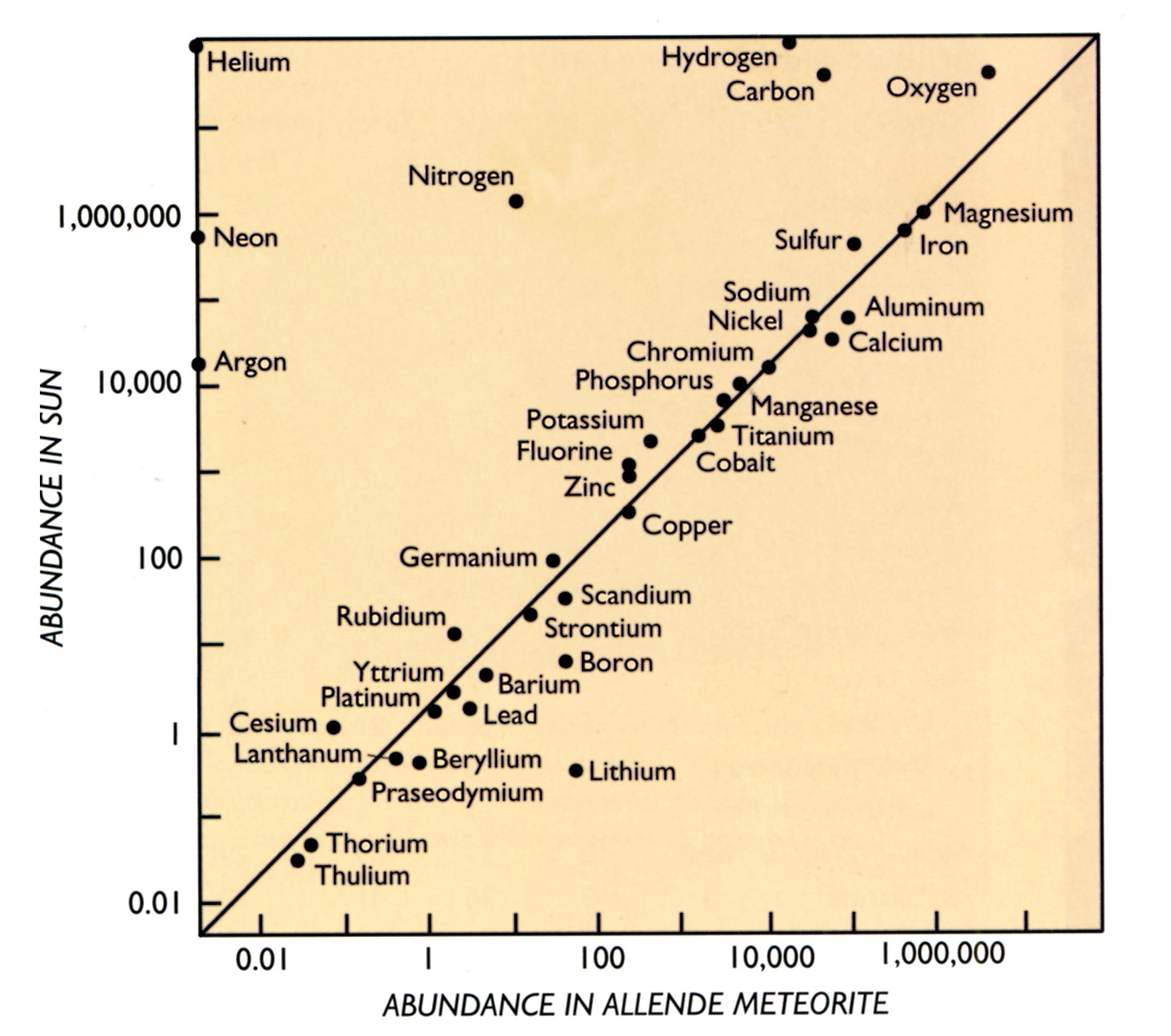
These meteorites are probably very similar to the primitive nebular material from which the planets formed. The fine grains in these meteorites are composed of hydrated silicate minerals and may contain up to 20 percent water. They are also rich in other volatile elements, but they also have flecks of metallic iron and other inclusions that formed at very high temperatures. Carbonaceous meteorites have low densities, about 2.3 g/cm3. Such meteorites, and other materials with approximately the same composition, are undifferentiated. They have not undergone any process, like melting, that segregates elements because of their chemical affinities or properties. All other meteorites (irons, stony-irons, and achondrites) are differentiated. They depart from this primitive composition in one way or another. The carbonaceous chondrites have survived for billions of years with little change since their formation from the gas and dust of the solar nebula. They are thus a type of genesis rock. The black matrix material in the chondrites can be described as a sticky agglomeration of this condensed dust. Various dating techniques show that the chondrites formed 4.6 billion years ago, establishing the age of the solar system. Many models of planetary formation assume that the inner planets and the rocky portions of the outer planets accreted from materials with approximately the same chemical composition as the primitive chondrites.
Not all chondrites have primordial compositions rich in volatile elements. Some show differences that are evidence that they formed in warmer parts of the nebula, and some have textures and minerals produced by secondary alteration inside small planets. Many of the latter have experienced varying degrees of thermal metamorphism but have never melted and are often called ordinary chondrites because they are more abundant than carbonaceous and other rare types. Recrystallization at elevated temperatures enhances the growth of larger crystals, partially destroying the original chondrule shapes and matrix textures. From studies of the included metallic grains, it appears that these metamorphosed chondrites cooled slowly after they were heated while tens to hundreds of kilometers deep within planetoids. The outer layers of these bodies acted as insulating jackets, protecting them from cold space, and allowed them to cool slowly.
The chondrites, then, preserve evidence bearing on the time of nebular condensation, the chemical compositions and sizes of the bodies created, the manner of condensation, and subsequent heating and metamorphism
The other main group of stony meteorites, the achondrites, has no chondrules. But more than this, the compositions and textures of many are very similar to basalt, the most common kind of lava found on Earth and the Moon (Figure 3.3). They also lack the metal grains found in chondrites. Achondrites are igneous rocks. They were either formed by the extrusion of igneous magmas on the surfaces of planetoids or as impact melts produced during flash heating events when two bodies collide. Their geochemical characteristics show that an igneous origin is likely for many. The parent magmas probably formed by partial melting within small bodies that had an overall chondritic composition. As the material heated up and melted, droplets of dense metallic iron formed and moved to the center of the planetesimal. A fraction of the low-melting temperature materials, predominantly silicates, formed magma that rose to the surface because of its low density. Achondrites may be thought of as part of a light scum, or crust, of silicate minerals surrounding the differentiated interior of a small planetoid. Fragmentation of a parent body may have sent small pieces of this crust toward Earth. Because of this more complex history, achondrites are not similar to the bulk composition of the solar nebula. Chemical differentiation of elements from one another occurred during partial melting inside a planetesimal.
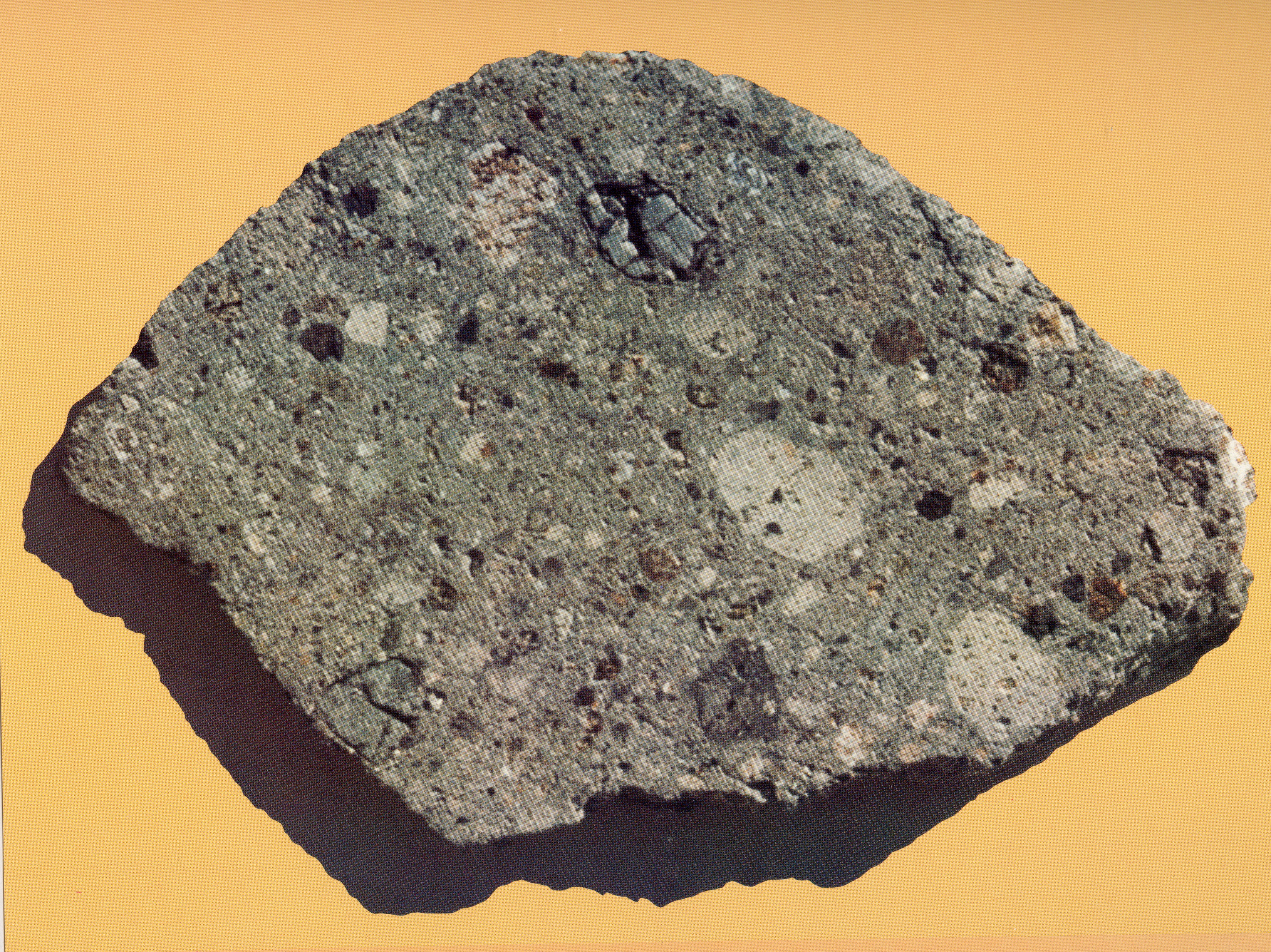
If achondrites were produced by melting inside an asteroid, we can gain a general idea of the size of the parent body. Melting could only have occurred in larger bodies, with diameters of hundreds of kilometers. Such bodies could retain enough heat, no matter how it was produced, long enough to melt portions of their interiors. Smaller bodies rapidly radiate away any heat produced before internal melting occurs. The asteroid Vesta, 538 km in diameter, is thought to have an outer layer of achondritic rocks. Achondrites are rare. Apparently, few were produced, or few survived subsequent obliteration. Of the achondrites recovered, many are brecciated and must be regolith (fragmental soils) produced by impact on their parent bodies.
Radiometric dating of achondrites shows that most are 4.5 to 4.6 billion years old, but a few distinctive specimens are as young as 1.3 billion years old. These crystallized 3 billion years after most meteorites formed and at least 1 billion years after the last volcanic rocks erupted on the Moon. These rare achondrites (shergottites, nakhlites, chassignites or SNC meteorites) have other distinctive features that suggest to some investigators that they were generated on Mars. More than 100 such meteorites are known, and their numbers are growing as new examples are discovered. The possibility that SNC meteorites are from Mars makes them among the most treasured of all rocks on Earth. Perhaps grazing meteorite impacts on Mars ejected fragments at velocities high enough to allow them to escape from the planet.
This exciting possibility is highlighted by the discovery of several small meteorites that originated on the Moon. Discovered mostly in Antarctica, they have all of the characteristics of the lunar rocks returned by the astronauts (see Chapter 4). Meteorites from more than 30 separate falls have been linked to the Moon. Careful searches through the large and growing meteorite collections may reveal SNC and lunar meteorites, giving us samples of large planetary bodies that are otherwise unobtainable.
Meteorites of the second major group are composed of approximately equal proportions of metal and silicate minerals and are called stony-iron meteorites (Figure 3.4). They are quite rare; only about 70 are known to exist, Some are brecciated and contain inclusions of other meteorite types. The unique makeup of this class requires internal differentiation by igneous processes of bodies near the size of large asteroids (hundreds of kilometers in diameter). As these bodies-which originally may have had chondritic compositions-heated and melted, heavy iron and nickel separated from the molten rock and sank to the center, making a liquid core. At the same time, the lighter silicate minerals or magmas rose to the surface. Although some stony-iron meteorites are impact-produced mixtures, many appear to represent fragments of a transition zone between metallic core and rocky mantle. They may have formed surrounding a massive central core or on the margins of several smaller pockets of molten metal dispersed through an asteroid like raisins in a pudding.
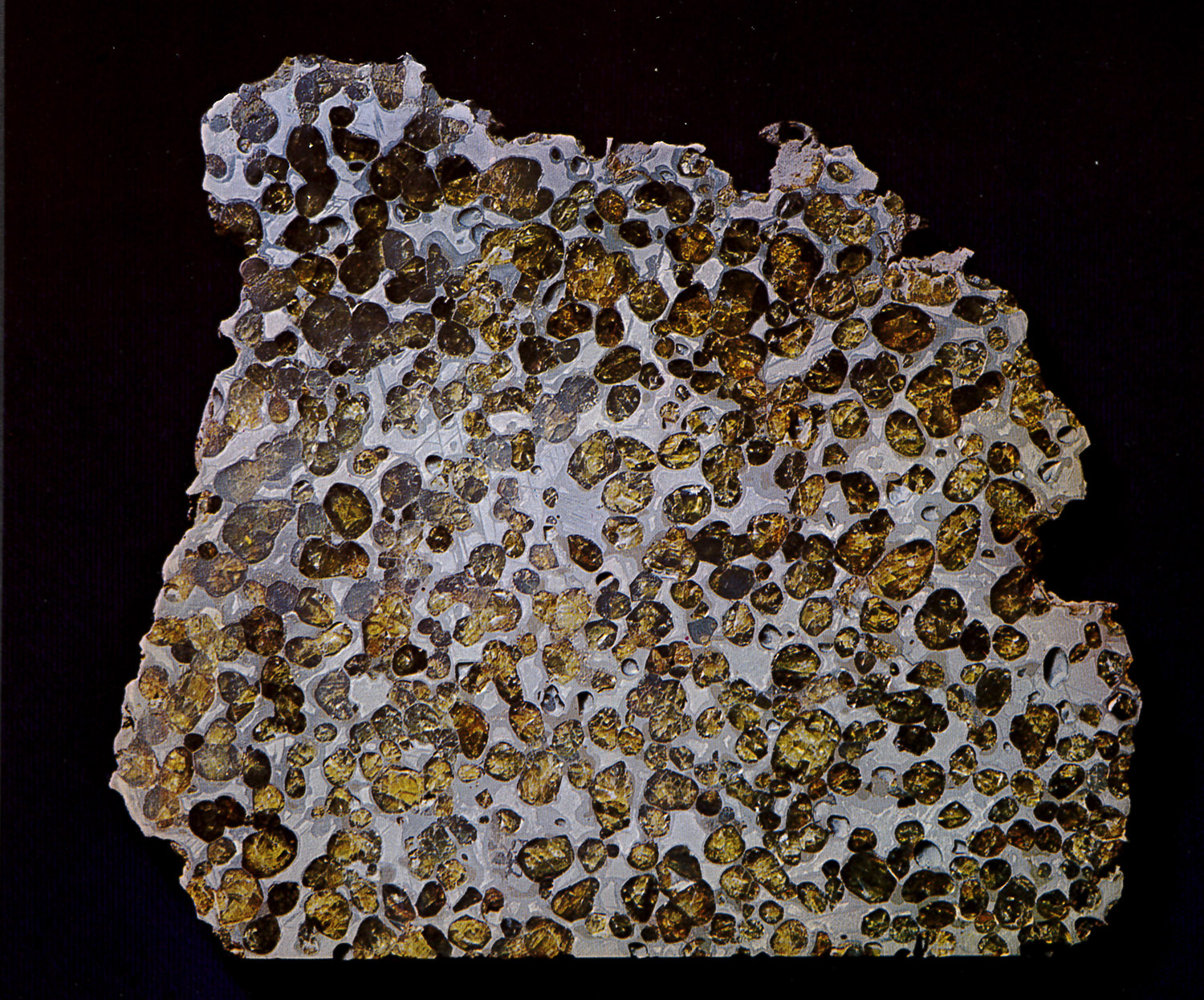
The most familiar, although not the most numerous, meteorites are largely composed of iron and nickel metal (Figure 3.5). Because these meteorites are very durable during their atmospheric passage and resist weathering on the surface of Earth, a disproportionate share of meteorite finds (not falls) is of this type. Many impressive meteorites on display in museums are large irons. They develop their typical melted and pitted appearance as they heat up during atmospheric passage. Before any meteorite reaches the surface, some of its original mass has either fragmented or ablated away.

When cut, polished, and etched with an acid solution, most iron meteorites display distinctive crosshatch patterns, called Widmanstatten structures, that show the internal arrangement of the metallic alloys in the meteorite. From studies of these structures, scientists have shown that these meteorites were originally molten. Cooling rates have been determined from the composition and size of the iron-nickel grains. Most cooled less than 10 K per million years. A small metallic body 1 km in diameter would cool very quickly. In fact it could cool from the temperature of molten iron in about 1000 years if left uninsulated in space. Thus, larger parent bodies, 20 to 300 km (but probably smaller than 1000 km) in diameter that insulated these cooling bodies of iron and nickel and slowed the cooling rate to observed values must have existed. This evidence indicates that iron meteorites originated as the cores of small planetesimals about the size of asteroids. An asteroid core was produced when heavy metals collected toward the centers of hot, fluid, differentiating bodies. The accumulations of metal may represent central cores in completely differentiated parents or only small scattered pods in a partially differentiated planetoid
From this simple overview, it can be seen that meteorites have actually recorded and preserved for billions of years the products of some of the major events in the early history of planetary bodies, both small and large. Ages determined from isotopic analysis of the different groups cluster around 4.6 billion years ago. We use these ages to establish the age of the solar system-the point at which solid material began to accumulate into sizable bodies. The undifferentiated carbonaceous chondrites have compositions that are similar to what we think was the composition of the solar nebula. Thermal metamorphism of other meteorites was caused by early planetary heating. Brecciation resulted from accretion or from later impacts that fragmented the bodies. Differentiated meteorites inform us about the nature and extent of the internal reworking that occurred even in small bodies.
Investigations of meteorites are consistent with a simple developmental model. The various chondritic meteorites are products of direct nebular condensation; later, some were mildly metamorphosed. Melting in larger bodies with chondritic compositions produced differentiated planetoids. Differentiated meteorites are crust-to-core samples of several bodies-achondrites are igneous crustal rocks; stony-irons are apparently fragments from mantle-core transition zones; and iron meteorites were once parts of cores formed deep within small bodies.
In addition to the major planets that circle the Sun, thousands of smaller planetoids are also part of the solar system (Figure 3.6). These minor planets are called asteroids; each of them is as different from the next as the major planets. There are over 10,000 known asteroids, but many others are far too small to be observed from Earth even through the best telescopes. The larger ones only leave blurs on photographic plates, to the distress of many astronomers looking at objects far from our tiny solar system.

By the late eighteenth century, it was recognized that the planets occur at what seem to be predictable intervals from the Sun. Uranus was discovered near the distance predicted, but no planet existed in the gap between Mars and Jupiter. The first asteroid, Ceres (1000 km in diameter), was discovered in 1801 and was thought for a time to be the missing planet. But Ceres was disappointingly small. Soon, other asteroids were discovered in the same region of the solar system and, when this fact was combined with the recent acceptance of meteorites as fragments from small bodies in space, some scientists postulated that a much larger planet had once existed there but had exploded and sent debris throughout the inner solar system. Subsequent studies of meteorites and asteroids have established that there never was a large planet between Jupiter and Mars, but the emerging story is just as intriguing. In the light shed by meteorite studies, we now know much about the present state and evolution of the asteroids.
Asteroids travel in closely associated groups or families with anywhere from 10 to 60 in a group. Those groups that orbit between Jupiter and Mars are called the Main Belt asteroids, of which there are, quite literally, millions (Figure 3.6). The Main Belt is 280 million km across, and all of the largest asteroids are confined to this group. Almost 5000 Main Belt asteroids have been numbered and have well-known orbits. Members of another, smaller group travel in orbits that cross Earth's path; they are called the Apollo asteroids. They have highly elliptical orbits and may be the source of much of the meteoritic material that reaches Earth's surface. At present, it is estimated that about 1000 bodies larger than 1 km in diameter are members of the Apollo group. Their numbers may once have been much larger, but many of them impacted Earth, Moon, Mercury, or Venus. Alternatively, gravitational perturbations and collisions in the Main Belt may serve to replenish the numbers of Apollo asteroids. Decaying or disrupted comets may also contribute to the number of Apollo asteroids in the solar system (see Chapter 14). Certainly some of these asteroids collided with the inner planets to form the impact craters prominent on several of the planets.
Although most of the asteroids are small, several are large enough to be considered minor planets (Figure 3.7). Ceres is nearly 1000 km in diameter, a little less than one-third the size of the Moon. Two, Pallas and Vesta, are over 500 km in diameter, and about 3000 exceed 20 km in diameter (Figure 3.7). For every asteroid, there are ten others one-third its size. This size distribution, with high numbers of small sizes, is probably produced by collisional fragmentation within the asteroid belt. Meteorites recovered on Earth bear evidence of impact disruption in their brecciated natures and small sizes. Within the asteroid belt, relative speeds between bodies often approach 5 km/s. A collision of two bodies at this speed could produce thousands of smaller fragments or even disrupt an entire body, exposing its deep interior. Nonetheless, in spite of repeated collisions in the asteroid belt, there does not appear to be a superabundance of very fine particles. Meteoroid-impact detectors on board the Pioneer 10 and 11 spacecraft discerned no change in the impact rate when crossing the belt on their way to Jupiter. These fine particles are fairly evenly distributed between the planets. Apparently, many are swept into the Sun.

Few of the asteroids are massive enough to have taken on spherical shapes like the larger planets and moons. Just as surface tension in a drop of water forms a spherical shape by deforming the original shape of the drop, so do planetary bodies attempt to take on spherical shapes by deformation resulting from gravitational forces. A sphere is a low-energy configuration, with the smallest possible surface area to mass ratio of any geometric shape. However, the small mass of, and consequently low gravitational force generated by most asteroids is not sufficient to alter their shapes radically (Figure 3.8). The materials the asteroids are made of are stronger than the gravitational force that they establish. Mechanical processes, impact, and fragmenttation are responsible for their irregular shapes, as is the case for the only two asteroids photographed by passing spacecraft, Ida and Gaspra. Other asteroids probably include the tiny martian moons, Phobos and Deimos. The martian moons, along with a few satellites of the outer planets, are probably captured asteroids. Much can be learned about the geologic processes of asteroids by close examination of Gaspra, Ida, and the moons of Mars, Phobos, and Deimos.

The first pictures of an asteroid to show surface details were taken in 1991 by the Galileo spacecraft on its circuitous journey to Jupiter (Figure 3.8). Gaspra orbits near the inner edge of the Main Belt, in the Flora region (Figure 3.7). The Galileo images show that Gaspra is small and the most irregularly shaped (18 by 10 by 9 km) planetary body yet observed. The asteroid is crudely cone-shaped, but a giant depression about 8 km across scallops the top, and another the bottom of the asteroid. Its reddish coloration and brightness as observed from telescopes on Earth show that it is similar to most asteroids in this region. This type of asteroid is thought to be composed of iron metal mixed with pyroxene and olivine- two common iron-magnesium silicates. As Galileo swept past Gaspra, it also detected a magnetic field. This field, comparable in strength to Earth's, is probably not caused by convection of molten metal inside Gaspra. It is inconceivable that Gaspra is warm enough to support internal convection. Rather, the magnetic field is probably caused by permanent magnetism of the metal in Gaspra. The magnetism measured in iron meteorites is consistent with this hypothesis.
The surface of Gaspra is composed of smooth facets separated by prominent ridges, spines, and smooth lumps related to the scallops. Impact craters are the most prominent landforms on these facets. As expected, cratering by small objects must be an important process in this part of the asteroid belt. About 60 impact craters have been identified. The largest is only 1.6 km across, less than twice as big as Meteor Crater in Arizona. The largest craters, seen in some detail, have bright, raised rims but no obvious ejecta blankets surrounding the crater, Gaspra has an extremely small gravitational field, and most fragments thrown up by impact should escape to space and never fall back to its surface.
near the top of the image of Gaspra shown in Figure 3.7. These grooves are several kilometers long and 100 to 300 m deep. They occur in several groups or radiating sprays. All of these features suggest that they are the surface expressions of deep fractures in the bulk of Gaspra. Where did they come from? Again, impact and partial fragmentation seem to be the most likely explanation.
The number of craters on Gaspra provides important information about the age of its surface. If a body is completely broken apart or buried by lava flows, a new surface is created with no impact craters. With the passage of time, more and more craters accumulate on the surface. Thus, the number of craters in a given area is proportional to its age. An approximate calibration of the impact record can be made by comparing radiometric ages of lava flows sampled by astronauts on the Moon with the number of craters on the same flow. This is described in more detail in the next chapter. If we compare the number of craters on Gaspra with a comparable area on the Moon, we can estimate the age to be less than about 300 million years old and perhaps as young as 20 million years old. This is a truly remarkable conclusion, particularly in view of the 4.6 billion year age of the solar system indicated by meteorite studies. Remember: this age is not an estimate of the time that the rocky material in Gaspra solidified, but rather an estimate of the time that has passed since the surface of Gaspra was created. If Gaspra is metal-rich and strong, its surface age could be older. On the other hand, if the number of projectiles in the asteroid belt is higher than in the Moon's vicinity, its surface age could be even younger. What is important to note here is that the surface of Gaspra is only lightly cratered as compared to the Moon and most other planetary satellites.
Why would the surface of Gaspra be so young? Hints come by considering its geologic setting, irregular shape, and grooves. Gaspra is only one of many asteroids that orbit near one another. When small bodies hit Gaspra, small impact craters formed. But it is not unreasonable to expect that occasionally larger asteroids collide with one another in catastrophic events. The irregular shape is a testimony to Gaspra's tumultuous past. The conclusion is that Gaspra is probably a fragment of the most recent catastrophic collision between a larger precursor Gaspra and another asteroid. The depressions and ridges could be giant spall zones caused by the collision that created Gaspra. Perhaps, thousands of smaller bodies were produced in the same event. Some may still orbit near by, but no evidence of orbiting debris as small as 50 m in diameter has been found.
More clues to the nature of the asteroids were revealed by Galileo's pictures of Ida taken in 1993 (Figure 3.9). Ida is more than twice as big as Gaspra, but it also has an irregular shape, measuring 56 by 24 by 21 km. Its color and reflectance are similar to Gaspra's but it may have less metal and more silicate minerals. Galileo showed that Ida has a magnetic field like Gaspra's
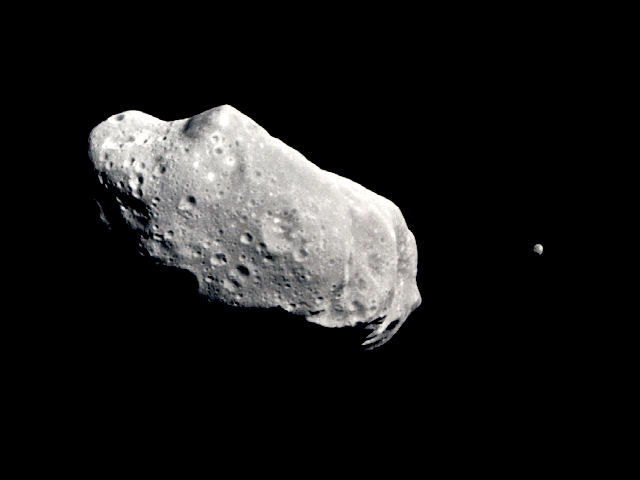
The most dramatic difference between Gaspra and Ida lies in the great abundance of impact craters on Ida's surface. Craters of every size are visible. Huge, incomplete crater walls define Ida's irregular outline. Using the same logic discussed above, crater counts for Ida imply that its surface may be 2 billion years old, roughly 10 times as old as Gaspra's. Somehow it appears that Ida has escaped recent fragmentation
A small moon of Ida was discovered lurking in the background of the photos taken by Galileo. This is the first asteroid moon to be discovered, but such moons may be quite common in the asteroid belt. The moon may be a fragment of Ida blasted away in an ancient collision.
Phobos is the larger of the two small moons of Mars (Figure 3.10). Its overall shape is irregular (some call it potato-shaped) and is the result of cratering and fragmentation. Its longest dimension is only 27 km. Impact craters are the most common landform and occur uniformly over the surface. Some of the crater rims have blocks that may be impact ejecta returned to the surface in spite of the low escape velocity. But most crater rims lack boulders or any evidence of surrounding ejecta blankets. The escape velocity on Phobos is just a little over 10 mls; an object tossed from the surface would go into orbit around Mars. Stickney, the largest crater, is 10 km across and covers a large fraction of the entire planetoid.
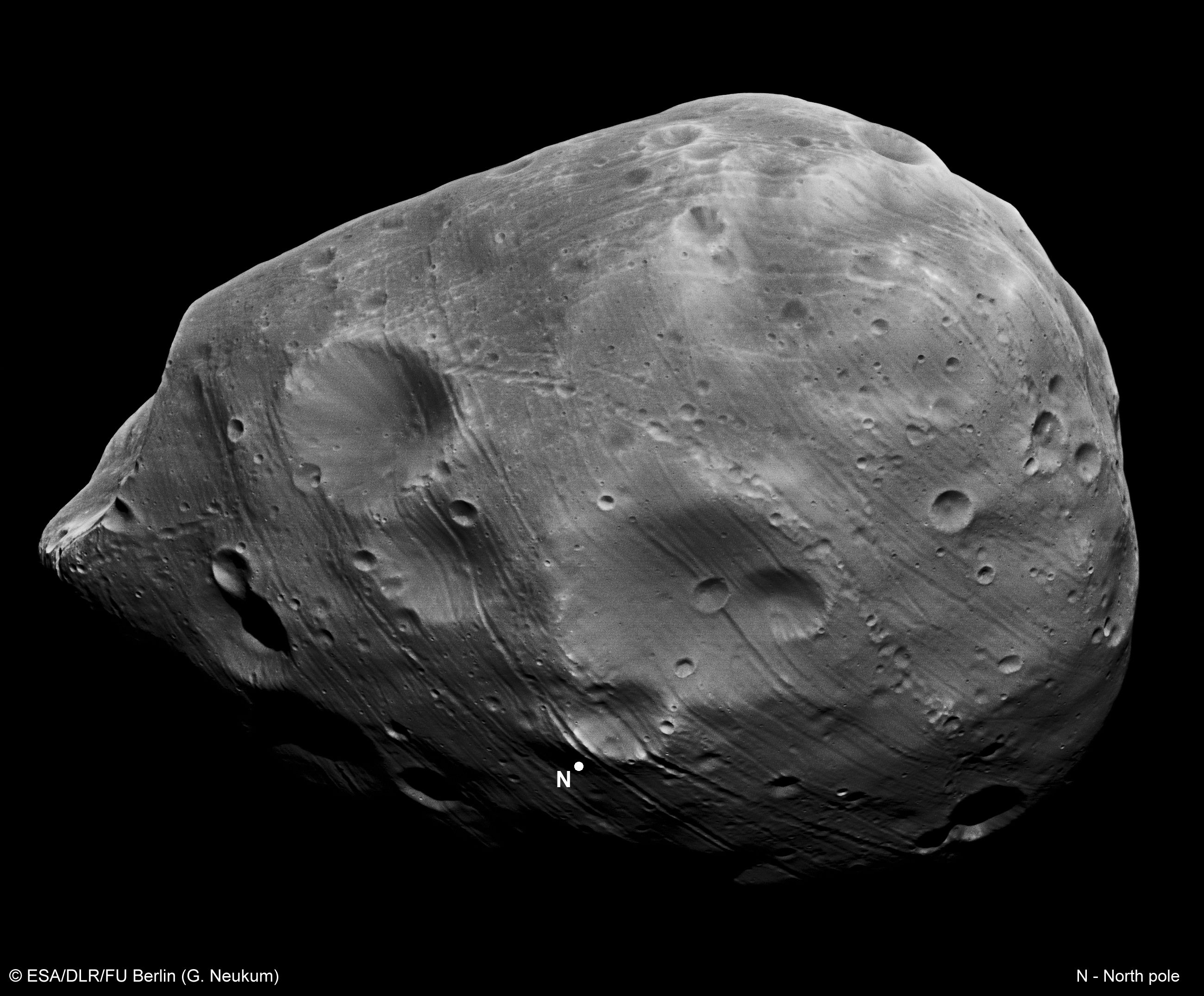
The most dramatic features on Phobos are a series of linear grooves (Figure 3.10). The grooves are similar to but more spectacular than those found on Gaspra. Most are between 100 and 200 m wide. The grooves appear to be related to Stickney, and they probably formed as Phobos fractured during the impact of the meteor that created Stickney. Some of the grooves are beaded and appear to be a series of pits. This may be caused by slumping of the regolith into the fractures, partially filling them in. The thickness of the regolith layer on Phobos may be up to 100 m deep and must consist of a veneer of finely pulverized material, resulting from repeated impact fragmentation. Layering is visible in some crater walls. Smooth intercrater areas may consist of a thicker blanket of this regolith.
Both Phobos and Deimos have low densities, around 2.2 (± 0.2) g/cm3 for Phobos and 1.7 (± 0.2) g/cm3 for Deimos. It has been postulated by some that they consist of easily fractured, volatilerich carbonaceous chondrite material. The size, shape, and orbital properties of Phobos suggest that it started out as an asteroid but was scattered from the outermost asteroid belt by Jupiter. The gravity field of Mars later captured it, making it a small moonlet.
The smaller martian moon, Deimos, is also irregular in shape and has a diameter varying from 11 to 15 km. Photographs of Deimos taken from the Viking orbiters show that it is quite different from its companion satellite (Figure 3.11 ). Although Deimos, too, is densely cratered, its surface appears much smoother than the pockmarked surface of Phobos. It seems to be mantled with a thick layer of dust or debris that buries many of the craters and ridges. Apparently, Deimos developed a much thicker regolith layer than did Phobos. Small boulders are scattered around a few of the craters. Because of the very weak gravitational fields, these are the only components of crater ejecta that can be retained on the surface.
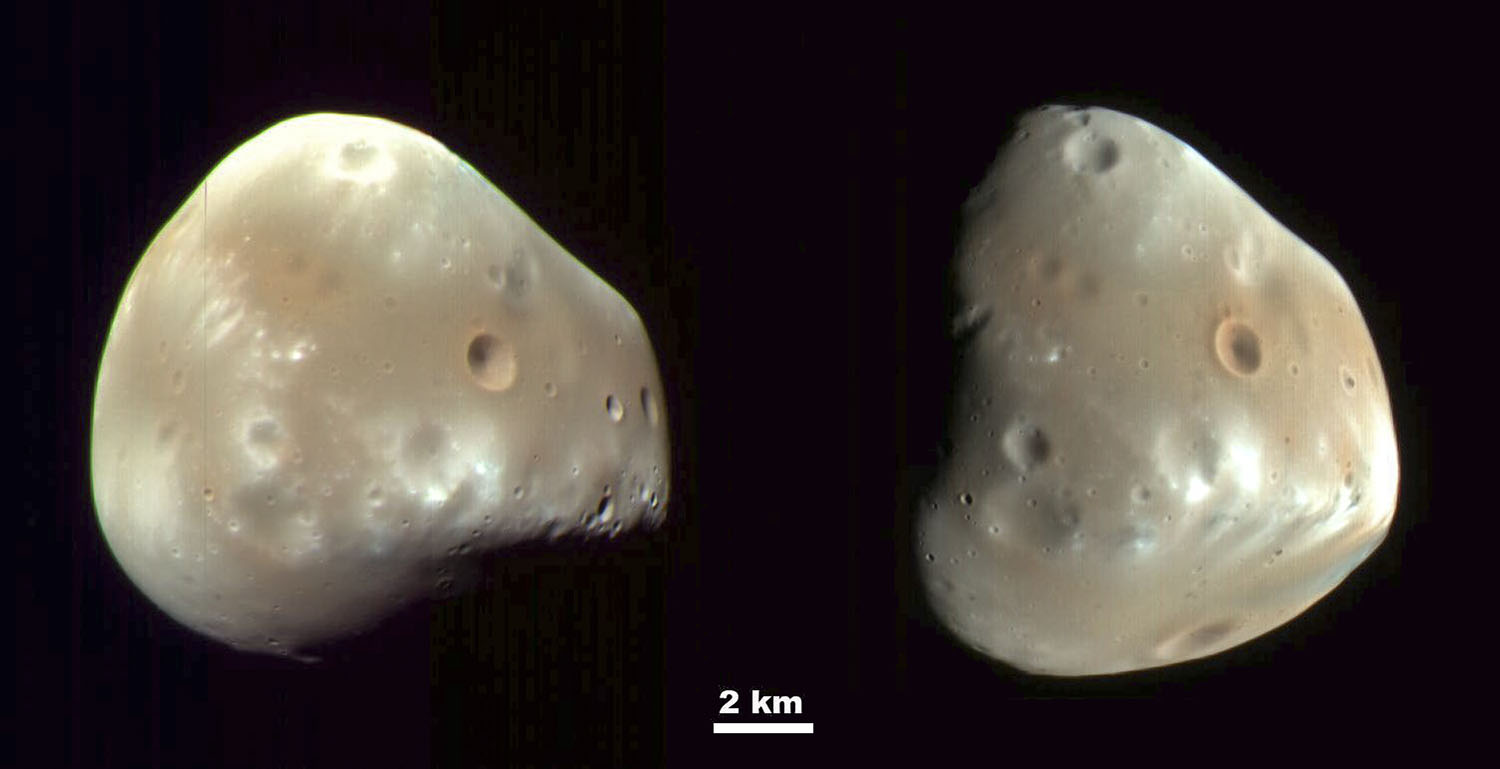
The images of Gaspra, Ida, Phobos, and Deimos radioed back to Earth are important because they show details of the smallest objects in the solar system yet observed in detail. Phobos and Deimos are very similar to the asteroids in the Main Belt from which they may indeed have migrated. Judging from what we see here, the asteroids are probably heavily cratered, battered fragments of once larger bodies.
Collisions between asteroids are probably the most important events presently taking place in the vast, sparsely populated regions between the planets. Impact processes have probably determined the size and shape as well as most of the surface features of the asteroids. One of the most striking differences between the appearance of craters on the asteroids and those on the Moon is the absence of ejecta blankets and rays. Escape velocities are very low; material ejected from craters can escape the gravitational attraction of many asteroids, and does not fall back to the surface to form ejecta blankets or bright rays characteristic of young lunar craters; only the largest blocks fall back on the surface. Some of the ejected debris may later hit other asteroids, creating many small craters. At even higher impact energy, as when these small worlds collide, an asteroid may be completely fragmented or a large chunk may be broken off, exposing the deep interior. For example, the formation of Stickney almost disrupted Phobos. Gaspra's young scalloped surface was created by collisional breakup of a once larger body.
Dramatic evidence of asteroid collision and fragmentation is revealed by images of asteroid Itokawa, which was photographed by the Japanese spacecraft Haybusa in 2005.Itokawa looks like, and probably is, a massive pile of rubble. It is made of two irregular pieces, probably formed when the body broke up after a massive impact or more smaller asteroid fragments moved toward each other and then gravitationally stuck together. The two segments are now joined to form a contact binary (Figure 3.12). The two pieces measure only 200 and 100 m across, and are themselves heavily fragmented. Hayabusa collected and returned to Earth tiny grains from the surface of the asteroid. And just like the meteorites it consists mainly of the mineral solivine, pyroxene, plagioclase, and iron sulphide like those found in chondrite meteorites.
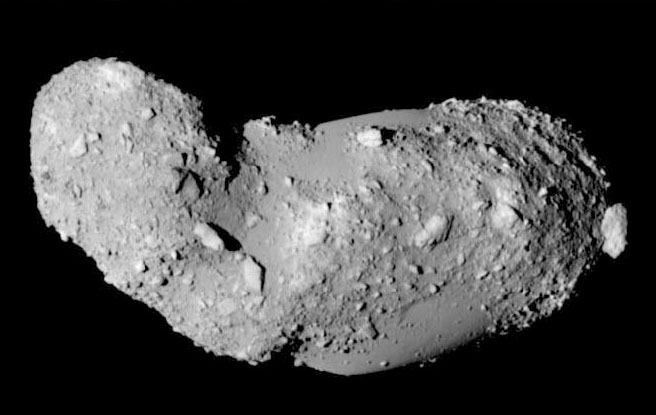
Asteroids have recently become objects of intense interest for planetary astronomers. They occupy the transition zone between the dense, volatile-poor terrestrial planets and the ice- and gas-rich outer planets and satellites. Obviously, a thorough understanding of their nature and origin is very important. New instruments and techniques have allowed scientists to gather data that help to determine the surface composition of these bodies. The brightness of the asteroids can be measured, using telescopes on Earth, in different colors or wavelengths of light, employing a technique called spectroscopy. All minerals absorb and reflect specific wavelengths (or colors) of light, which are diagnostic of the chemical composition and structure of the mineral. When this spectral information is combined with measurements of the brightness of each asteroid, a good idea can be obtained of its mineralogic composition. Over 600 asteroids have been "fingerprinted" in this way.
These studies have revealed that several distinct spectral types of asteroids exist. Let us examine a few of the interpretations of this data (Table 3.3).
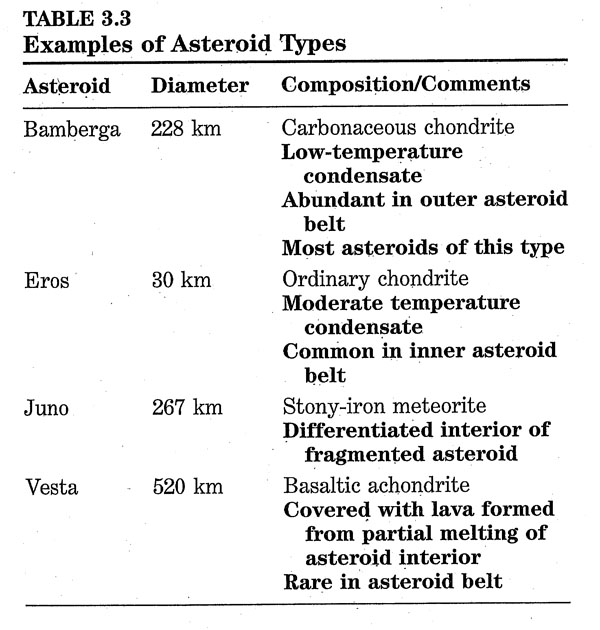
Asteroid 324, Bamberga, is a dim object, difficult to trace from Earth, in spite of its relatively large size. It has a diameter of 228 km. The asteroid has a black color imparted by what appear to be carbon compounds. Comparisons with the light spectrum of carbonaceous chondrite meteorites indicate that Bamberga may be of this composition. Even though these bodies are dark and difficult to see, the most numerous objects in the asteroid belt are of this type and appear to be volatile-rich carbonaceous material. The distribution of sizes within this asteroid class is dominated by very small bodies, indicating that the individuals are pieces of once-larger bodies fragmented by repeated collisions. Carbonaceous chondrite meteorites may be pieces of bodies like Bamberga delivered to Earth.
The spectral properties of the small, irregularly shaped asteroid Eros (maximum diameter of 30 km) indicate that it has quite a different surface composition. It appears to consist of iron and magnesium silicates and appears to lack the carbonaceous coating of Bamberga, a mineralogic makeup that resembles metamorphosed chondritic meteorites. These chondritic meteorites are poor in volatiles, suggesting that they condensed at a relatively high temperature or that they lost their volatiles shortly after condensation, during metamorphism
The surface of Juno, 267 km in diameter, appears to be comprised of a mixture of silicate minerals (olivine and pyroxene) and metal, (probably iron and nickel) that resembles no terrestrial rock but is very similar to certain stony-iron meteorites. Such a mixture is strong evidence that Juno is a chemically differentiated body that experienced a strong thermal event during its history. If its differentiated interior is now exposed at the surface, Juno may be a fragment of a once larger body.
The three largest asteroids (Ceres, Vesta, and Pallas) are unique in many ways, but some inferences about their natures can be made. Ceres, the largest asteroid, is just under 1000 km in diameter (and is sometimes included in the dwarf planet category along with Pluto). Its spectral properties suggest that, like Bamberga, it is most probably composed of carbonaceous materials. Hydrous silicates, also found in carbonaceous chondrites, have been identified on its surface. Water ice has also been detected on Ceres. In accord with this suggestion is its relatively low density (2.3 g/cm3).
The second largest asteroid (Vesta, over 500 km in diameter) is unique among the asteroids so far studied. Its surface layer is comprised of pyroxene-rich rocks, like achondrite meteorites, which, as we discussed earlier, were most likely lavas erupted on the surface of small planetoids. Vesta was apparently one such object and has preserved much of this volcanic shell. Temperatures must have been very high to allow melting. Vesta also displays variations in the light reflected from its surface as it rotates. These variations may be evidence of other rock units on its surface, perhaps exposed by impact or alternatively not covered by achondrite lavas
Pallas is only slightly larger (533 km diameter) than Vesta but appears to be more like Eros in its composition, that is, rich in iron and magnesium silicates
Although many different spectral types and attendant mineral compositions are recognized in the asteroid belt, several generalizations can be made from the interpretations of the spectral data. Almost three-fourths of the asteroids appear to be similar to carbonaceous chondrites. Like Bamberga, they consist of volatile-rich material that probably condensed directly from the planetary nebula at low temperatures and are found mostly in the outer belt, far from the Sun (Figure 3.13). Even water ice has been detected in the outer part of the asteroid belt. There is little indication of any postaccretionary thermal events in these asteroids or their meteoritic equivalents. Another 15 percent of the asteroids seem to be similar to Eros, composed of iron and magnesium-rich silicate minerals, olivine and pyroxene, with little dark carbonaceous material. Judging from what we think are their meteoritic equivalents, these asteroids may never have been melted, but metamorphic or condensation temperatures must have reached 1100 K (about 820 C) within relatively shallow layers. These asteroids are apparently not as rich in volatile compounds as the first group described and are most common in the inner asteroid belt, that part closest to the Sun. Other, relatively rare, asteroids appear to be composed of iron metal or iron-nickel alloys with a silicate component, similar to Juno. The separation of the metallic phases probably occurred deep within small planetesimals when they became nearly molten; temperatures probably exceeded 1700 K. Most of the metallic asteroids are 100 to 200 km in diameter and do not appear to be fragmented like the other types of asteroids. These highly reflective asteroids are concentrated in the central to inner part of the asteroid belt.
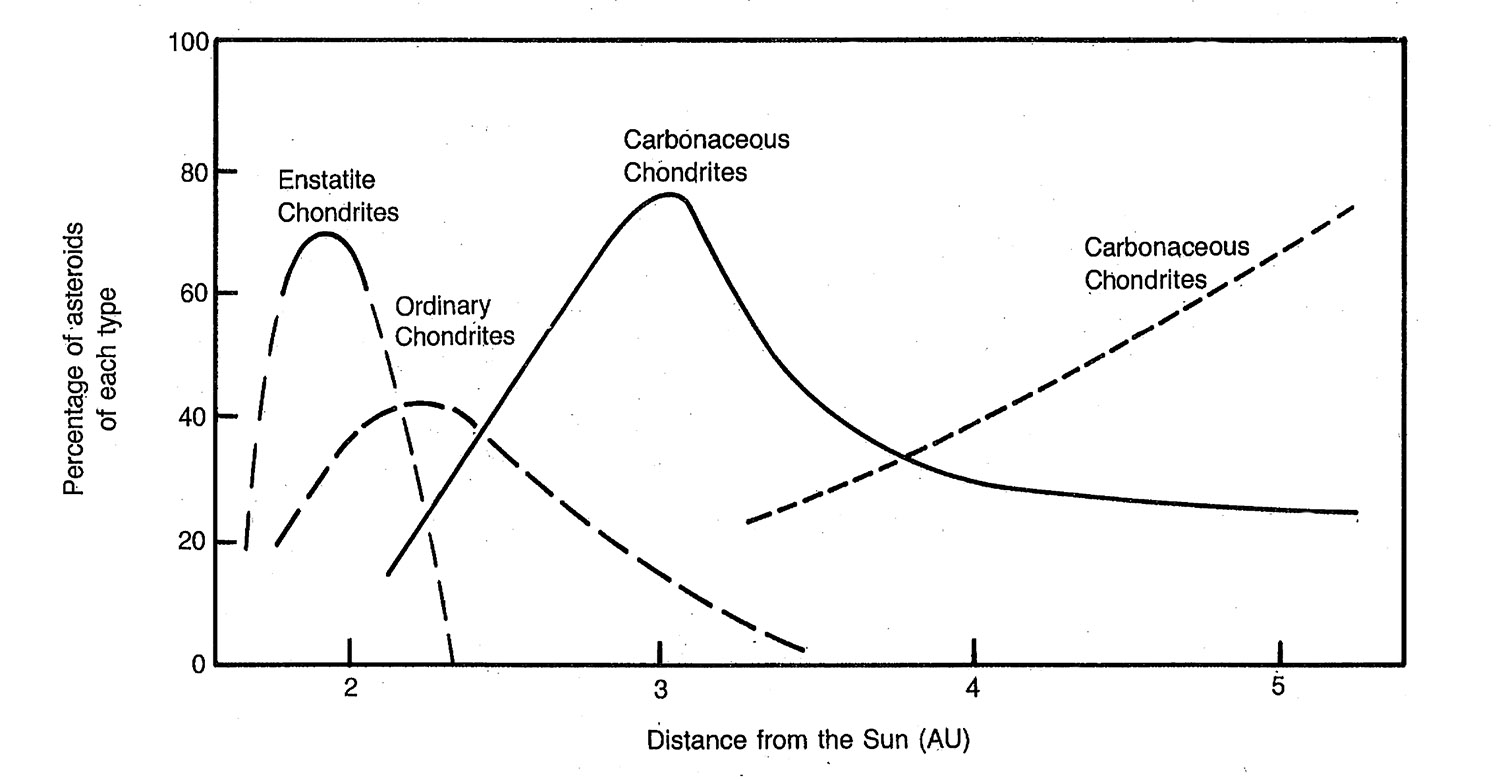
From this information about the zonation of the asteroid belt, it appears likely that the silicate dominated asteroids closer to the Sun condensed at higher temperatures than those that are near Jupiter. Some of the larger bodies appear to have experienced a degree of internal chemical differentiation. Zones composed of an inner metallic core, a metamorphic silicate mantle, and possibly a volcanic veneer (for Vesta) formed on these parent bodies. Subsequent collisions stripped away and fragmented the rocky mantle and crusts, exposing iron-rich cores (Figure 3.14). These metallic cores were stronger and less likely to fragment than the rocky outer layers and therefore preserved much of their original mass, explaining their relatively large, uniform sizes. Fragments of asteroids such as these that reached Earth would be iron meteorites (from the core), stony-irons (core-mantle interface), metamorphosed chondrites (mantle) and achondrites (volcanic veneer).
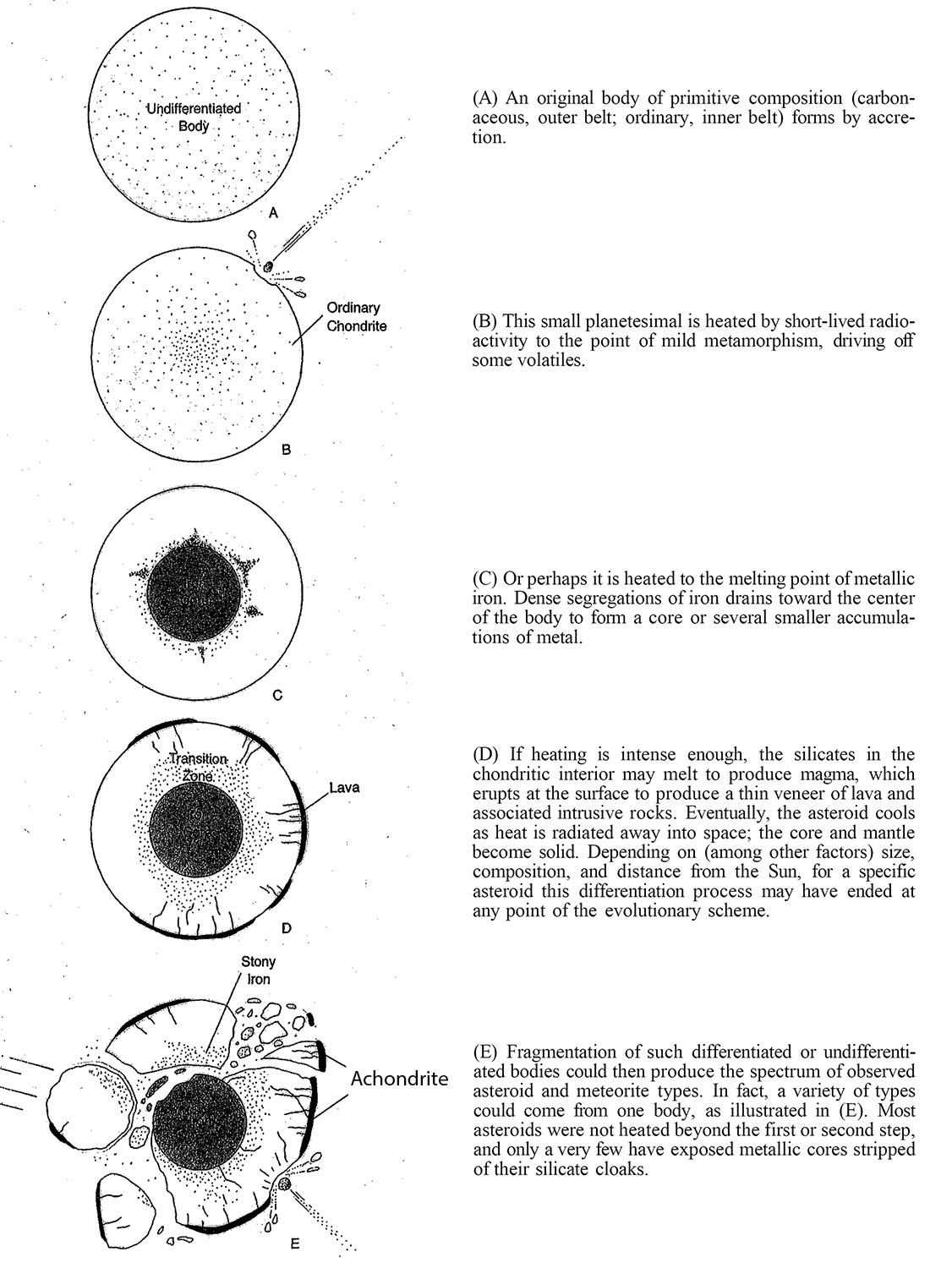
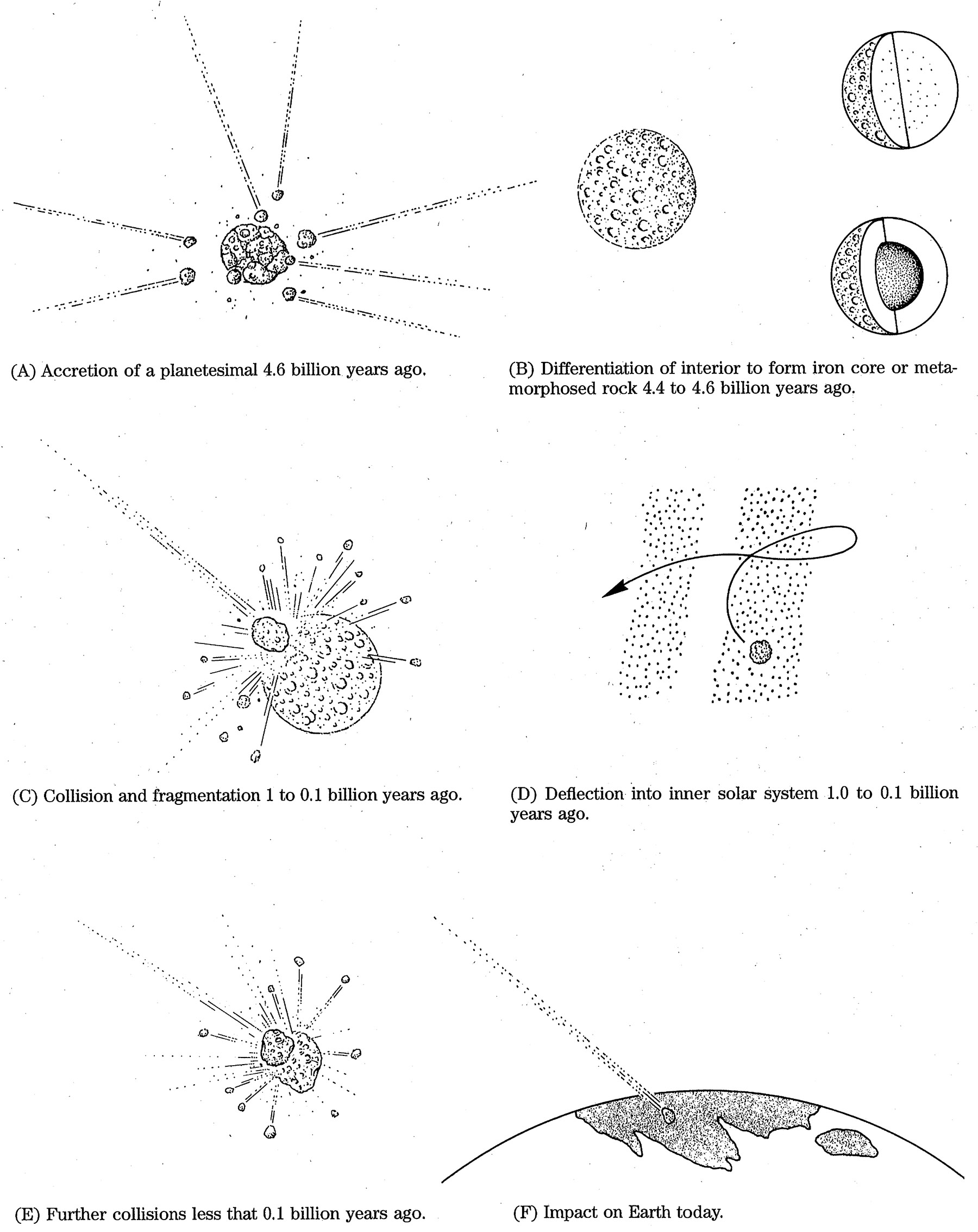
Other asteroids farther from the Sun accreted from low-temperature condensates and did not melt; some may have reached temperatures high enough to produce mild metamorphism (Figure 3.14). These asteroids appear to be the largest and occupy the outer part of the asteroid belt. When delivered to Earth, fragments of these bodies are called chondrites and carbonaceous chondrites.
From the vast store of information collected by scientists on Earth and with robotic spacecraft, we can answer many important questions about the origins of meteorites and their relationships to asteroids. Many types of meteorites have counterparts in the asteroid belt; a few come to us from the Moon and perhaps Mars. Still other meteorites appear to have been delivered to Earth by comets.
Nonetheless, many questions about meteorites and their small parent bodies remain. The source of the heat that tremendously altered some meteorite parents still remains a problem. Were the asteroids heated by now-extinct radioactive elements or did early solar activity heat some to melting? Geochemists have found evidence that short-lived isotopes such as iron (60Fe) and aluminum (26Al) were present in early meteorite parents. Rapid decay of these isotopes inside asteroids may have provided a short thermal spike of sufficient intensity to melt and differentiate bodies as small as a few hundred kilometers across. However, it is difficult to reconcile radioactive heating with the steep temperature gradient across the asteroid belt. Consequently, other scientists point to the early Sun as an important heat source. Strong radiation and variable magnetic fields from the young Sun while it was going through a T Tauri stage (Chapter 2) may have heated asteroids to high temperatures by induction heating-a process akin to microwave cooking. In this case the outside of the bodies would be more intensely metamorphosed than the deep interiors. The exteriors of those asteroids nearest the Sun (within 2 times the Earth-Sun distance) may have melted completely, and those farther away (about 3 times the EarthSun distance) may not have been melted at all. Even farther away, water ice may have remained stable. This model does not require a special distribution of radioactive aluminum or iron. The pattern of spectral types in the asteroid belt indicates that both the distance from the Sun and the size (which determines the planetoid's ability to retain heat and the amount of radioactive elements) are important. In short, the source of heat to melt the meteorite parent bodies remains uncertain.
Why did thermal activity, manifest by the rare, young SNC meteorites, continue so long after radioactive or solar heat sources should have been ineffective? Is it possible that these young meteorites are really derived from a much larger body with a longer thermal history like Mars? The implications of this radical conclusion for our understanding of Mars are enormous and are being pursued vigorously.
Another problem yet to be totally solved lies in the numbers of individual bodies that exist in the asteroid belt. Why did these bodies not accrete to form a planet? Was there a much larger population of asteroids early in the solar system's history that was depleted as the inner solar system was peppered with impacting bodies? Certainly Jupiter's tremendous gravitational influence affected this turn of events. Possibly Jupiter accelerated the early planetesimals in this region just enough to produce net fragmentation rather than accretion, and then gradually perturbed their orbits so that asteroidal fragments entered the inner solar system, colliding with the surfaces of the planets.
Of course the answers are not all in yet, but further study of the physical nature of meteorites and asteroids and the evolution of their orbits and thermal histories will reveal more about the very early development of the solar system. Preserved in some of these small bodies are quantities of material left relatively undisturbed since the dawn of the planets. In others we can study the igneous and metamorphic changes that occurred deep inside differentiating planets. Moreover, these are the same sorts of planetesimals that, 4.6 billion years ago, accreted to form Earth and its neighbors in space.
1. Is it possible that any of the meteoritic material that falls to Earth each year comes from asteroids? From other planets? Cite any evidence.
2. What is the evidence that even small asteroids may have melted during their early histories?
3. Contrast the origins of the major classes of meteorites. Could a single asteroidal body give rise to all of these various types? Why?
4. What are the possible explanations for the zonation seen in the asteroid belt?
5. How and why did the parent bodies for meteorites differentiate? What does their differentiation tell us about the early history of the inner planets?
6. What sources of heat may have been important in the thermal evolution of asteroids?
7. What class of meteorites is most like the core of Earth?